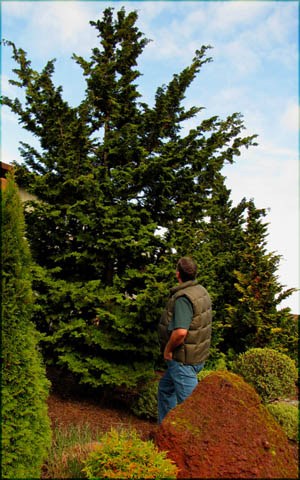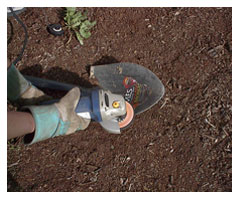
Transplanting Advice for Trees and Shrubs
Copyright 2004 - 2009 by Mario Vaden
Here are some tips for transplanting trees and shrubs. If you don't rush, and follow a few basic principles, you can effectively move a tree or shrub with success. The photo was taken 2010, and shows a 17' tall Hinoki cypress that I transplanted in 2003, when it was 10' tall at the tip.

Professional tree movers may use specialized equipment, but shovels and picks are among the most reliable moving tools for home gardeners or professionals. One overlooked planting tool is a small grinder like the one in the photo below. A convenient tool to keep shovels sharp.
If the plant is larger, or established, it may be better to wait a year and prepare the rootball. A root ball root mass can be made more dense by promoting more small roots with cutting and digging the circle of the root ball in advance. This will sever many surface roots in the top 10” to 12”.
Just as cutting twig tips of a plant's branches enables it to thicken with small twigs as when developing a hedge, likewise, smaller roots can develop within a rootball after a perimeter circle is cut to root prune and establish the width of the rootball. Extra development of more small roots will help keep the ball and soil intact better when it's time for the move.
If the plant is small like less than 11' tall or trunk diameter less than 3", or if the rootball has good root density, immediate transplanting may be fine. It may be fine to move large trees right away too if there is enough root mass for a decent rootball. Use a sharp shovel - Sharp tools:
a. Cut better - less chance of breaking a shovel.
b. Make work easier - less effort is required.
c. Cut better - fewer roots are damaged
d. Cut better - less ankle stress and injury.
e. Cut better - shatter the rootball less - roots get cut, not hammered.

advertisement
If the move must be done in warm weather, consider spraying the canopy with an antidesiccant to seal moisture in. Ask at your garden or landscape supply center, and read the label before purchasing or applying the product.

You could thin out 10% to 20% of the branches or foliage to reduce the amount of leaves that will be “demanding” water from the reduced-size root system after the move. There are two sets of opinions about this, but it's worked for me, and it seems logical. But its fair to add that some research indicates its okay to leave most of the limbs. Usually, I'm just removing branches that get in the way of digging, grabbing or staking the tree if needed after the transplanting move. When you dig for the final transplant:
a. Dig a circle, or re-dig the preparatory circle again that marks the outer boundary of the root ball. This is an inserting and cutting with the shovel - not a soil removal digging cut. This cut is done facing the plant as you go around the perimeter of it. I prefer to keep the shovel blade nearly vertical for this cut: possibly slanted 5 to 10 degrees.
b. Next - turn 90 degrees, so your left, or right shoulder is facing the plant (you will be standing “sideways” to it. You can now "dig out" a trench outside the circular cut you made earlier. By standing sideways, your shovel will not be prying into the root ball. This reduces the likelihood of shattering the root ball. The smaller the chunk of soil removed with each cut, the less the disruption and shattering of the rootball. Often, its better to slice and shovel away 1" at a time, instead of 5" ten pound chunks.
c. After digging the trench, you can face the plant again and cut another circle around the perimeter of the ball, but about 1 foot deeper, and at a bit more of an angle (the shovel handle will be leaning a bit more toward your body on this cut).
d. Again, dig, enlarge and deepen your trench or around the perimeter, digging standing sideways to the ball. Again, that method conveniently reduces prying and fracturing the rootball during this transplanting project. You will be able to tell when it is useful, and when you may need to switch to facing the plant. The “facing sideways” technique is useful for the upper 1 foot or 2 feet of depth. But at some point in time, you will be digging with any means possible to remove soil and leave the ball intact. Especially if you find a stone that gets in the way.
If the ball is very heavy, you may want to dig a ramp on one side of the hole, to slide the rootball out rather that do a direct upward lift.
Inexpensive tarps are a good tool to improvise with, for transplanting a rootball. Once the root ball is dug, and that plant can be freely rocked back and forth, a tarp can be inserted under it to move the ball. Lean the plant sideways, so 1/2 of the tarp can be wadded under the ball. Then lean the plant the other direction so the wadded part of the tarp can be pulled through. This should leave the plant or tree nearly centered on top of the tarp. Now, 1, 2, 3 or 4 people can grab the corners of the tarp, and lift and slide the plant out of the hole - up the ramp if you included one. As the tarp corners are lifted upward, the root ball is cradled and supported. A tarp can also be wrapped and tied around the rootball for a short period of time, like overnight storage, or to move the plant to another location. The tarp is removed by sliding the plant in the new hole, and reversing the rocking and wadding method. You can also use burlap to cradle and wrap the root system.
Once the tree is slid or lowered into the new planting hole, consider using the shovel handle or a stick to pack soil into the hole while back-filling, and eliminate air pockets. You won't want to crush the soil to the point of compaction, but you don't want to leave air “pockets” either .
I don't recommend adding a nitrogen fertilizer in the process of planting. Maybe in a year if the soil test shows nutrient deficiency. But I've seen too many trees loose their natural form from unneccessary fertilizing. You may enjoy our page about root feeding.Recent research indicates that newly planted trees do well without pruning for a year or two. Keep that in mind. But I find no reason to leave branching defects on the day of planting. My preference is to remove the defects while they are tiny or smaller, but keeping the corrective pruning to a minimum.
Unless the soil is very bad, there should be little need to ammend the backfill soil as long as the excavated soil is broken up and loosened.
Don't dig the new hole deeper than the depth of the tree rootball. It may be better to dig a hole that's 1" to 2" shallow. Holes that are too deep can settle and cause the tree's root mass to drop below grade. That is not good. It's better for a tree to be planted a bit high, than too low.
Barkdust or mulch, can greatly improve the growth of a transplanted tree and secure it's chances for survival. If a tree is carefully transplanted (one with a good rootball), and properly mulched, survival should be anticipated. Many newly tranplanted trees need temporary support by staking. For other tree related information, visit the albums page for the album with various tree care images.

advertisement